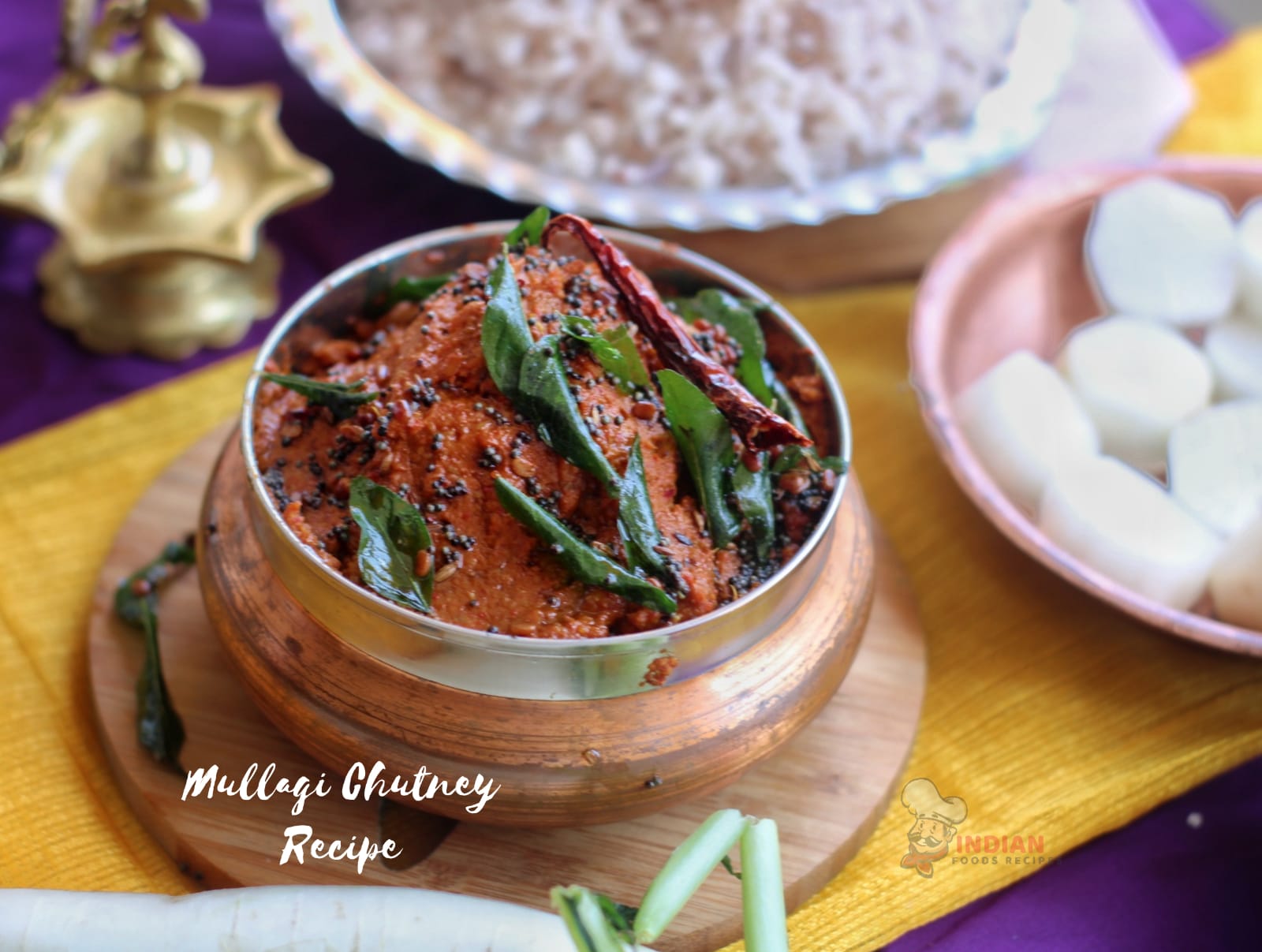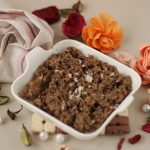Radish Chutney / Mullangi Chutney
Go for a fiery dip Mullangi Pachadi to accompany your all time favorite potato wedges with a glass of buttermilk and a chilled carrot cucumber salad..
An Outlook On Radish Chutney / Mullangi Pachadi
Its Origin:
Chutney has always been an indispensable accompaniment in any Indian Thali, and it is prepared using different lentils, spices and vegetables. There are a number of variations in each type of chutney and it differs from region to region depending upon the season, staples and cuisines. If we take a look into the gastronomic history of India, we can see a lot of varieties of chutney made of different kinds of vegetables and pulses and they have been passed on to generations with ardent fervor and fondness, not only for its deliciousness but also for the health benefits it holds within. Mullangi Pachadi or the radish chutney is one such unique dish that is famous in the states of Andhra Pradesh for its fiery taste and toothsome texture.
All About Mullangi Pachadi:
Mullangi Pachadi makes an awesome accompaniment for Indian starters which has a nice taste and lingering flavor. If you want a different dip for your regular evening crisp, you can certainly try out this simple yet an amazing recipe. The combination of radish with freshly grated coconut along with roasted urad and chana dal makes it all the more palatable. The mildly pungent taste of radish is balanced with a pinch of tamarind and it becomes delicious when tempered with a spoon of sesame oil. A plate of steamed hot rice with a dash of ghee, topped with radish chutney and a crunchy bite of papad, tastes fantabulous for a cozy sunday lunch, and you can prepare it in bulk and store in the refrigerator for about a week approximately and can use if for roti, idli, dosa, appam Idiyappam and upma varieties.
Radish - Its Varieties:
Radish is one of the perennial vegetables in India and some of the common varieties of radish are pusa desi, pusa chetki (North India), Nadauni (Himachal Pradesh) Japanese white (south India), Rapid red white tipped, Arka Nishant and Scarlet globe (all over India) and its taste is pungent and mild peppery over all which comes with the shape of round, tubular and oblong structures. Moreover, the red globe radish is used as garnishing agent for soups, salads and sandwiches as it adds a hot peppery flavor to the dish. Spring radish is mild in taste and used in cooking while the winter radish is used in vegetarian curries and stews.
Radish- Its scientific name and geographical factors:
Its botanical name is Raphanus Sativus and this tuber belongs to the Brassicaceae family and it is an edible root vegetable that grows worldwide, and there are a plenty of varieties that differ according to the habitat and the climatic condition in which it grows. It is cultivated for its roots, leaves, seeds and seedpods and it grows from the size of 2 cm to 1m long and some of the common colors are red, pink, white, purple and black. It is a perennial taproot and an easy growing root that can be planted multiple times in a growing season and can be harvested quite rapidly like the time period of three to four weeks. It grows in light sandy loam soil.
Radish- Its Health Benefits:
Radish is loaded with astounding health benefits but ironically, a much underrated root in the Indian cooking owing to its availability and affordability. Radish is high on fiber and packed with vitamin A, C, B6, E and K. Apart from being high on anti-oxidants, it is also rich in potassium, magnesium, calcium, iron, manganese, copper and zinc. It boosts immunity and helps in reducing inflammation and early aging. It increases oxygen supply to the blood and regulates bile production, thereby protecting the liver and the gall bladder as well. It reduces acidity, gastric issues and nausea thus aiding in proper digestion. It is a super food during summers, as it has high water content and helps us to keep hydrated for long. It has been widely used in Ayurveda for its cooling properties and it also reduces hypertension. Moreover, the anthocyanins present in radish reduces the risk of heart related issues thereupon helping in proper functioning of the cardiovascular system and aids in cancer prevention too. It helps in treating urinary disorders and acts as a natural remedy to reduce fever while supporting in the treatment of several kidney disorders.
Radish- Its Contribution to Beauty:
It may surprise many of us when we come to know that it is one of the boon vegetables for skin and hair. A glass of radish juice when taken regularly gives you a fantastic skin tone and a healthy hair. It cures pimples, dry skin and hair with its amazing hydrating properties and it helps in maintaining a healthy skin and hair with its rich vitamin C, potassium, phosphorus and zinc. Radish face mask gives you a clear face without acne or rashes, while radish hair pack can alleviate dandruff and dry scalp. It strengthens hair root and therefore prevents hair loss too. It removes dirt from the skin pores and also the fine lines and wrinkles in the face, and thus a best home remedy for skin and hair related issues. The raw radish juice is a beautiful face cleanser and above all, it facilitates weight loss due to its no fat and no carbohydrate content. As it has a low glycemic index, it improves the metabolism efficacy of the body. Nature gifts us with such miracle vegetables which have abundant therapeutic properties and our ancestors have been very brilliant and responsible in identifying and consuming all nutritious substances in their day today life, and they have passed on the treasured recipes to the coming generations by practice. Let us make use of the age old recipes and keep ourselves healthy, happy and beautiful. Try out this easy recipe of radish chutney to give a nutrition boost to your body, skin and hair.
Here comes one of the mom's recipes the simple yet delicious Mullangi pachadi:

Ingredients Required To Make Radish Chutney / Mullangi Chutney / Mullangi Pachadi
How To Make Radish Chutney / Mullangi Chutney / Mullangi Pachadi
Take a fresh and tender radish and peel its skin off after washing it well.
Grate it using a grater and keep aside.
Heat a Kadai and tip in a quarter teaspoon of sesame oil and drop four or five dried red chilies and lower the flame.
Stir in for a while and after a minute or two, just add the measured quantity of chana dal to it.
Keep stirring and when it gets roasted, just toss over the measured quantity of urad dal along with a piece of soild asafoetida.
Let the lentils get roasted and when it turns golden brown, squirt in a tablespoon of grated coconut along with a large piece of fresh ginger.
Finally add the grated radish and roast altogether in low flame for about five minutes approximately.
When the whole mixture turns aromatic, turn off the flame and let it cool for sometime.
Drop the ingredients in a blender and add the measured quantity of tamarind and sprinkle the required amount of rock salt.
Splash in a little water and make a thick and coarse paste out of it.
Transfer it to a bowl and heat a small pan and tip in a teaspoon of sesame oil in it.
When it is heated, just toss over a teaspoon of mustard seeds to it.
When it starts to splutter, add in half a teaspoon of broken urad dal and follow it up with a roughly torn dried red chili.
At last, sprinkle in some fresh curry leaves and let it sizzle too.
Stir in the tempered ingredients to the Radish Chutney and serve it with hot rice, idli or dosa along with a cup of filter coffee.
Some Useful Observations:
- Choose a heavy, slender and firm radish and if possible with the greens on top (to ensure that it is absolutely fresh) because you can never underestimate the taste of freshly picked ones.
- Chop the greens and refrigerate to add for soups and salads and can wrap up the remaining radishes in kitchen towels and store them in a glass jar and keep it in the refrigerator to last long. You can also saute them with a little oil and freeze in a zipper bag for long storage.
- I usually suggest solid asafoetida and rock salt to make chutneys, as it makes the dish more authentic and healthy as well.
- Freshly grated coconut gives the desired taste rather than frozen or tinned coconut powder.
- Other than sesame oil you can also use groundnut oil or any other cooking oil which you use regularly.
- You can also replace the dried red chilies with green chilies if you are a lover of green chili or if you would like the pachadi to be slightly greenish.
- Let the chutney be slightly coarse and reasonably thick if you prepare for rice and roti. Else, you can add a few drops of water and dilute a bit if you use it as a dip for a snack or savory.
- It suits well as an accompaniment for Idli, dosa, appam, Idiappam, kuzhi paniyaram, medu vada, adai, uthappam, potato bajji, bonda and punnugulu (Andhra special deep fried savory)
Ingredients
Directions
Take a fresh and tender radish and peel its skin off after washing it well.
Grate it using a grater and keep aside.
Heat a Kadai and tip in a quarter teaspoon of sesame oil and drop four or five dried red chilies and lower the flame.
Stir in for a while and after a minute or two, just add the measured quantity of chana dal to it.
Keep stirring and when it gets roasted, just toss over the measured quantity of urad dal along with a piece of soild asafoetida.
Let the lentils get roasted and when it turns golden brown, squirt in a tablespoon of grated coconut along with a large piece of fresh ginger.
Finally add the grated radish and roast altogether in low flame for about five minutes approximately.
When the whole mixture turns aromatic, turn off the flame and let it cool for sometime.
Drop the ingredients in a blender and add the measured quantity of tamarind and sprinkle the required amount of rock salt.
Splash in a little water and make a thick and coarse paste out of it.
Transfer it to a bowl and heat a small pan and tip in a teaspoon of sesame oil in it.
When it is heated, just toss over a teaspoon of mustard seeds to it.
When it starts to splutter, add in half a teaspoon of broken urad dal and follow it up with a roughly torn dried red chili.
At last, sprinkle in some fresh curry leaves and let it sizzle too.
Stir in the tempered ingredients to the Radish Chutney and serve it with hot rice, idli or dosa along with a cup of filter coffee.








